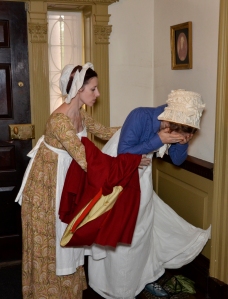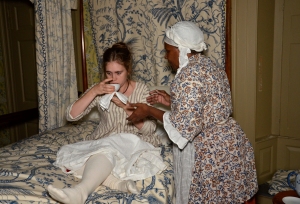Tags
authenticity, emotions, first person interpretation, historic house museums, interpretation, John Brown House Museum, museum practice, Rhode Island Historical Society, What Cheer Day

Petulant Alice faces her first hurdle, Kitty and Goody Morris. Photograph by J. D. Kay
I think about three or four things most of the time: food, sex, museums, and clothes. That seems pretty adequate, but from time to time I am forced to consider intersections between these rather broad topics. The intersectionality of clothing and museums seems pretty obvious: from accurate costumed interpretation to proper packing and storage, easy. Food and museums will be much on my mind in the coming year, as we work on “Relishing Rhode Island,” and I’m continually harping on how eating locally and seasonally is the core of eating historically. Sex and museums is a little harder (yes, I know about the Museum of Sex), though one gets a chance even in a historic house museum, and really, it’s not just about the act: it’s about the feels.

Mary assists Alice in the hallway as she prepares to face her mother. Photograph by J. D. Kay
In the main, I am not particularly good at the feels aside from some very hands-on experience with anxiety, but a number of things have coalesced recently to make me reconsider the intersection of emotions, museums, and history.
Hamilton is one, and if you read this, you probably watched the Hamilton’s America documentary on PBS last Friday. If you didn’t, go do it now. Really: I can wait. And here’s why:
In the thinking I’ve been doing for some time about Hamilton,* I’ve reached the conclusion that what makes it so damn good (aside from the brilliant writing) is how Lin-Manuel Miranda has captured the emotions. The quotes I wrote down from the documentary are about emotion and drama, because I’m looking for them (confirmation bias for the win) but here they are:
“Each piece of music is specific to an emotion and a character”
“I got into the history through the characters”
“Research is over and you write the character defined by history”
“Write the parts you think are a musical”

Goody Morris helps Alice drink lemon water to soothe her stomach. Photograph by J. D. Kay
What is a museum exhibit but “the parts you think are a musical?” While Our Girl History struggled with being Alice (I know a bit about the part where your ego gets connected to a character), she had to portray a character defined by history, but also by emotion. And in thinking about Hamilton, about What Cheer Day, and about the exhibits that give me pleasure, and art that brings me joy, I have reached a couple of conclusions.
I believe that museums, where we currently set educational and interpretive goals, and increasingly experiential goals, need to begin setting emotional goals for their programs and exhibitions. You could argue that experiential and emotional goals are the same, but I disagree: I believe that interpretation helps define the experiences that create emotional responses, and within the intersection of experience and emotion we will find the educational goal revealed, because we are always working within a content-driven context.

James checks on sister Alice. Photograph by J. D. Kay
I also believe the reason gun-based reenactments retain their popularity is their easy emotions. “Boom!” is exciting anywhere: there’s an immediate reaction of shock, surprise, a mild fear, and excitement. Traditional reenactments have those “boom!” emotions embedded within them, which is how they retain their potency. Until we locate the emotion within the everyday– and trust me, it’s there– we will not see the primacy of non-military reenactments and living history.
*Yes, I was aware of it when it was in previews at the Public Theatre. I am *that* kind of hipster, but really, it was because Oscar Eustis went from Trinity Rep here to the Public and there’s a PVD-NYC theatre connection.

You have me thinking about what emotions capture and what emotions repel. Whether a book, a movie, a show, or a performance, there are stories that capture me, that I fall in love with, that I am drawn to return to. These have tapped into my emotions. Equally, there are those I dislike, nearly detest, because they make my skin crawl or stomach turn, or induce the need to walk away, close the book or press the stop button.
For most, I would think the former would be the goal; those emotions that capture and induce a longing. (Though we are in the time of year where the latter has its own market.) How do were determine which are which, and which to develop in programming?
Excellent observations and question!
I think it’s tempting to prefer to go for the emotions that capture and compel, rather than repel, us. To stick with my endless example, Hamilton, I find the repelling parts are the relationship parts, as in the Reynolds affair.
But I also know that difficult emotions and struggles can be where we learn and grow the most, so I would argue that we need to balance compelling and repelling emotions. Museums are the safe spaces where we can experience difficult emotions and have difficult conversations, as well as experience positive ones.
I think I may finally have what I need to write about the USMC Museum at Quantico….
Kitty, you know I’m with you on this, because we spoke about it, however briefly, on the day of the WCD event. I’d like to add that repellent emotions are not only just as compelling in a museum experience, they are necessary. It might be said that the United States Holocaust Memorial Museum in DC was far ahead of its time in making “emotional goals” its priority for the museum goers’ experience, and rest assured, none of the emotions evoked there are pleasant ones.
That’s an excellent example. The Museum of Slavery came to mind, and the USMC Museum for its literally chilling Choisin Reservoir gallery.
We have to confront the truths of the past, we have to remember the terrible events. Museums are a place for not forgetting- but it’s important for the public to carry their experiences, what they learn and feel, out of the museum and into their lives.
Drunk Tailor’s example when we discussed this was the Enola Gay at the Smithsonian. That’s another very unpleasant symbol, and one that provoked wildly different reactions from the curators, the historians, and veterans–let alone Japanese Americans.
Pingback: Sideways Into Immersion | Kitty Calash
Pingback: Sideways Into Immersion | Kitty Calash